The Economics and Statistics Division maintains archives of previous publications for accountability purposes, but makes no updates to keep these documents current with the latest data revisions from Statistics Canada. As a result, information in older documents may not be accurate. Please exercise caution when referring to older documents. For the latest information and historical data, please contact the individual listed to the right.
<--- Return to Archive
For additional information relating to this article, please contact:
February 09, 2024LABOUR FORCE SURVEY: VISIBLE MINORITIES, JANUARY 2024 The Labour Force Survey asks respondents about whether they identify with visible minority categories (as used in the Census): White, South Asian (e.g., East Indian, Pakistani, Sri Lankan), Chinese, Black, Filipino, Arab, Latin American, Southeast Asian (e.g., Vietnamese, Cambodian, Laotian, Thai), West Asian (e.g., Iranian, Afghan), Korean, Other.
January 2024 (3 month moving average, unadjusted)
Nationally, the unemployment rate for those who identify as a visible minority population (7.2%) was higher than the unemployment rate (4.9%) for those that did not identify as Indigenous or in a visible minority population. All regions had unemployment rate higher for those who identify with a visible minority group than for those who did not identify as Indigenous or in a visible minority population. This gap was highest in Quebec while the lowest gap was in Alberta. In Atlantic Canada, the unemployment rate was 8.9% for those that identify with a visible minority group, and 7.5% for those that did not identify as Indigenous or in a visible minority population.

National participation rates were higher for those who identify with a visible minority population (70.4%) than for those that did not identify as Indigenous or in a visible minority population (62.7%). Participation rates of those who identify with a visible minority population were higher in all regions in January 2024. In Atlantic Canada, those who identify with a visible minority population reported a 77.1% participation rate, compared to a 59.1% participation rate for those that do not identify as Indigenous or in a visible minority population.
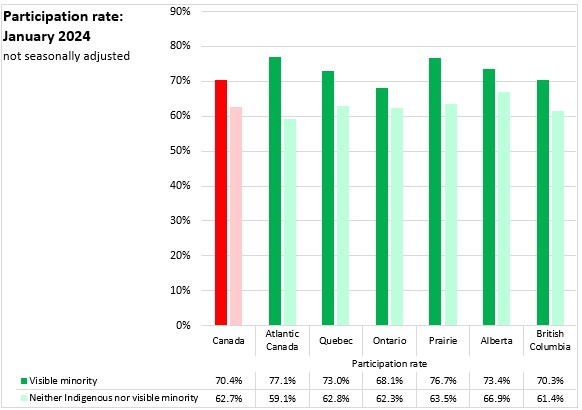
Nationally, employment rates were higher for those who identified with visible minority populations (65.3%) than for those who did not identify as Indigenous or in a visible minority population (59.6%). Employment rates were higher for those who identify with visible minority populations in every region when compared against those who do not identify as Indigenous or in a visible minority population in January 2024. The gap between the employment rates for those who identified with visible minority populations (70.2%) and those who did not (54.7%) was highest in Atlantic Canada.

Canada's unemployment rates were generally higher across visible minority populations than for those who did not identify as Indigenous or in a visible minority population (exceptions: Japanese, Korean and Filipino populations). Unemployment rates of females in specific visible minority populations were typically higher than unemployment rates among males (exceptions: Black, Filipino, West Asian populations).
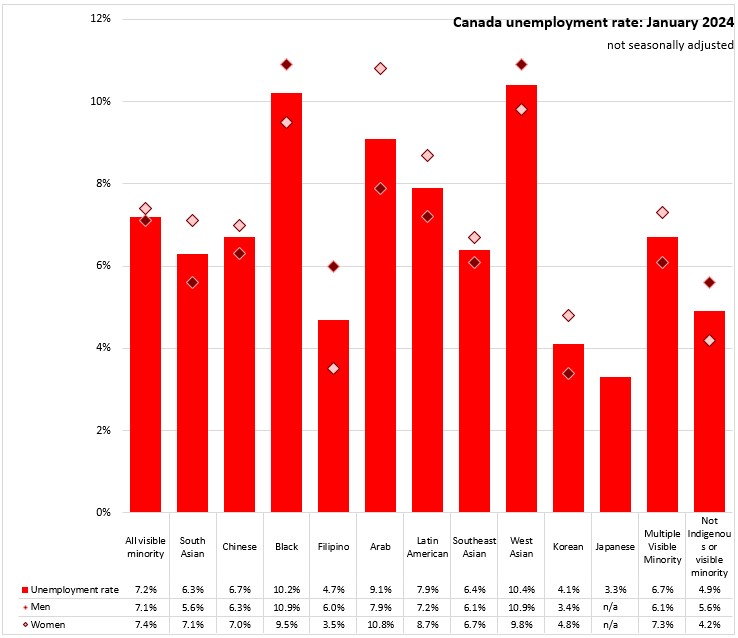
Labour force participation rates for those identifying with a visible minority were generally higher when compared those who do not identify as Indigenous or a visible minority (lower participation rates for Chinese populations). Participation rates were higher for men than for women among all visible minority populations (as well as among those who neither identified as Indigenous nor in a visible minority population).
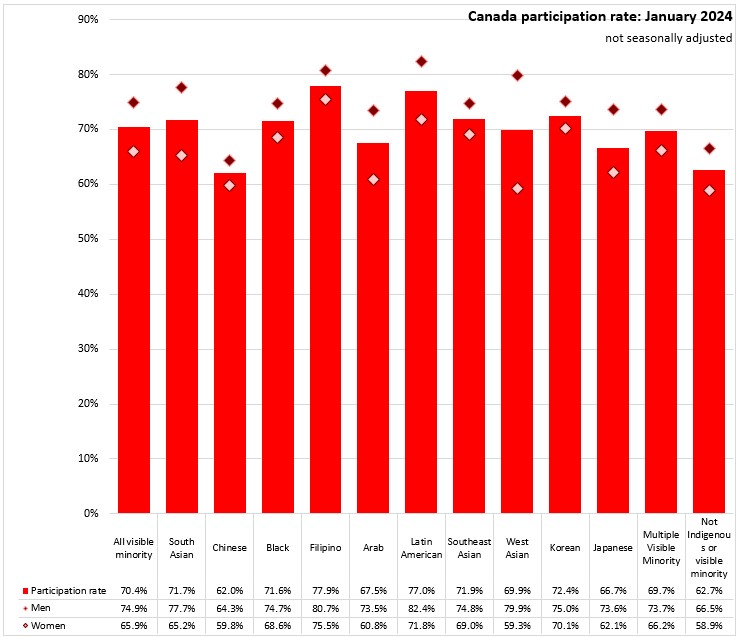
Employment rates were generally higher among visible minority populations than among those who identified neither as Indigenous nor as a visible minority (exception: Chinese populations). Men reported higher employment rates than women in all visible minority populations, as was also the case among populations that did not identify as Indigenous or a visible minority.
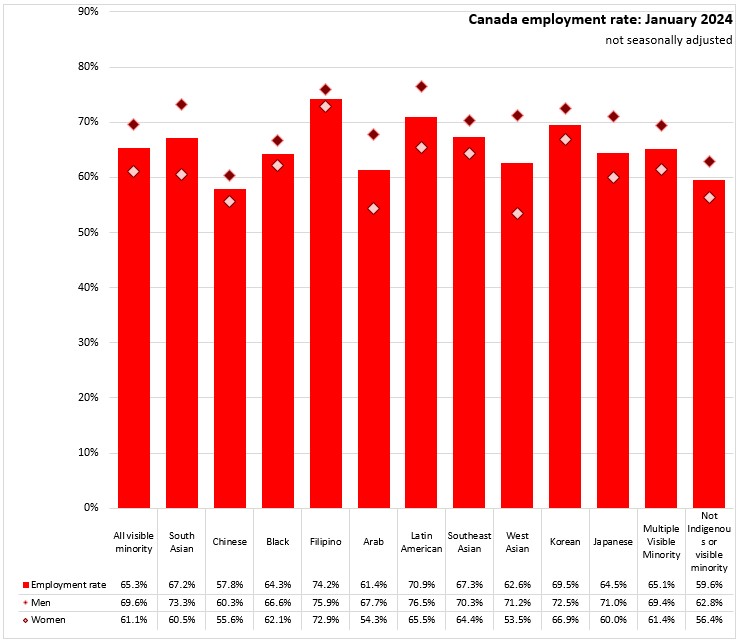
Unemployment rates in Canada were higher for all age cohorts of visible minority populations, when compared with those that do not identify as Indigenous or in a visible minority population. The largest gap was for youth (aged 15-24).

Participation rates of visible minority populations were higher for older workers, compared to the same age cohort that does not identify as Indigenous or visible minority populations. Among youth and core aged workers, participation rates among visible minority populations were lower than among similarly aged populations that do not identify as Indigenous or in a visible minority population.
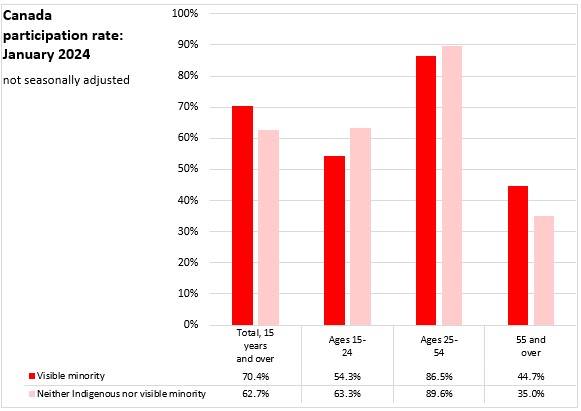
With lower participation and higher unemployment rates, employment rates were lower for visible minority youth and core aged populations than for those who do not identify as Indigenous or a visible minority population. With stronger participation rates (and despite higher unemployment rates), the employment rate of older visible minority populations was higher than older Canadians who do not identify as Indigenous or in a visible minority population.
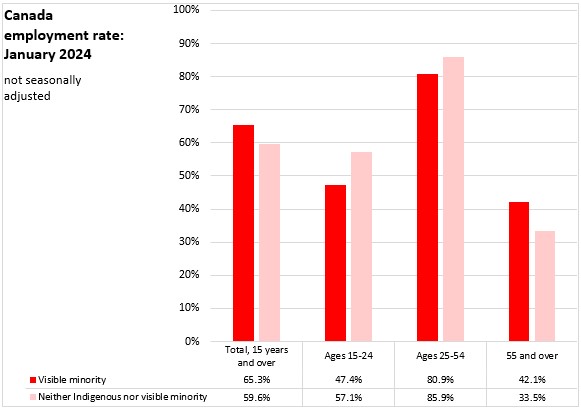
Trends
For the last 8 months, Atlantic Canada unemployment rates for visible minority populations have been higher than for those who identified as neither Indigenous nor in a visible minority population. This reverses the pattern observed through much of 2022 and 2023.
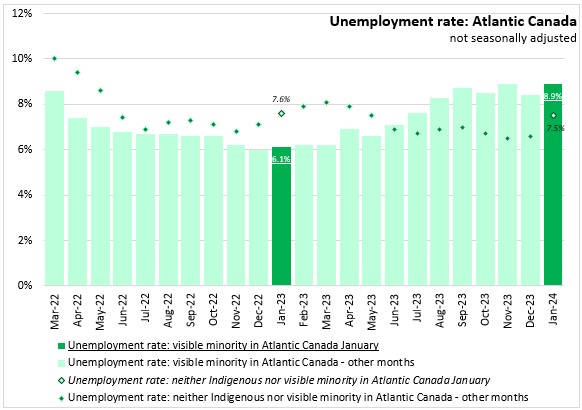
Participation and employment rates for visible minority populations in Atlantic Canada are consistently higher than those that identified neither as Indigenous nor in a visible minority population.
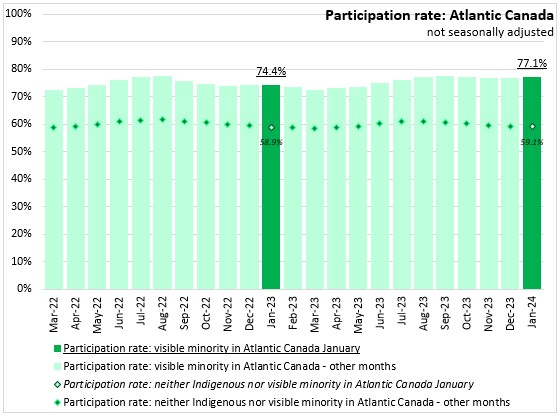
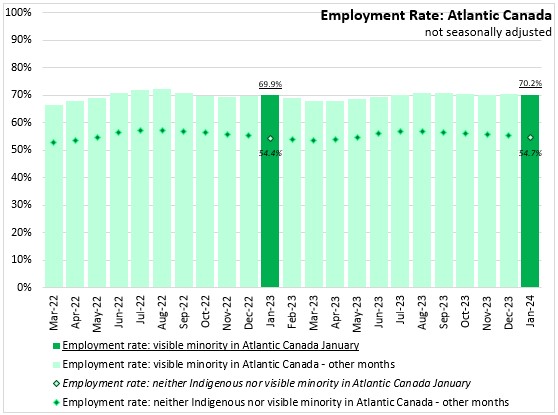
Source: Statistics Canada. Table 14-10-0373-01 Labour force characteristics by visible minority group, three-month moving averages, monthly, unadjusted for seasonality
<--- Return to Archive